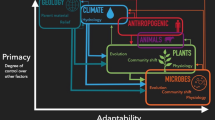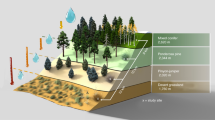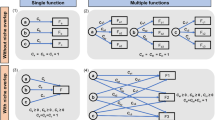Abstract
As the earth system changes in response to human activities, a critical objective is to predict how biogeochemical process rates (e.g. nitrification, decomposition) and ecosystem function (e.g. net ecosystem productivity) will change under future conditions. A particular challenge is that the microbial communities that drive many of these processes are capable of adapting to environmental change in ways that alter ecosystem functioning. Despite evidence that microbes can adapt to temperature, precipitation regimes, and redox fluctuations, microbial communities are typically not optimally adapted to their local environment. For example, temperature optima for growth and enzyme activity are often greater than in situ temperatures in their environment. Here we discuss fundamental constraints on microbial adaptation and suggest specific environments where microbial adaptation to climate change (or lack thereof) is most likely to alter ecosystem functioning. Our framework is based on two principal assumptions. First, there are fundamental ecological trade-offs in microbial community traits that occur across environmental gradients (in time and space). These trade-offs result in shifting of microbial function (e.g. ability to take up resources at low temperature) in response to adaptation of another trait (e.g. limiting maintenance respiration at high temperature). Second, the mechanism and level of microbial community adaptation to changing environmental parameters is a function of the potential rate of change in community composition relative to the rate of environmental change. Together, this framework provides a basis for developing testable predictions about how the rate and degree of microbial adaptation to climate change will alter biogeochemical processes in aquatic and terrestrial ecosystems across the planet.



Similar content being viewed by others
References
Adams HE, Crump BC, Kling GW (2010) Temperature controls on aquatic bacterial production and community dynamics in Arctic lakes and streams. Environ Microbiol 12(5):1319–1333
Aerts R (1999) Interspecific competition in natural plant communities: mechanisms, trade-offs and plant-soil feedbacks. J Exp Bot 50(330):29–37
Allison SD, Martiny JBH (2008) Resistance, resilience, and redundancy in microbial communities. Proc Natl Acad Sci USA 105:11512–11519
Allison SD, Wallenstein MD, Bradford MA (2010) Soil-carbon response to warming dependent on microbial physiology. Nat Geosci 3(5):336–340
Balser TC, Wixon DL (2009) Investigating biological control over soil carbon temperature sensitivity. Glob Change Biol 15(12):2935–2949
Bennett AF, Lenski RE (2007) Colloquium papers: an experimental test of evolutionary trade-offs during temperature adaptation. Proc Natl Acad Sci USA 104(Suppl 1):8649–8654
Bergwall C, Bengtsson G (1999) Phenotypic plasticity in groundwater denitrifiers. Oikos 87(1):123–128
Bradford MA, Davies CA, Frey SD, Maddox TR, Melillo JM, Mohan JE, Reynolds JF, Treseder KK, Wallenstein MD (2008) Thermal adaptation of soil microbial respiration to elevated temperature. Ecol Lett 11(12):1316–1327
Chu H, Fierer N, Lauber CL, Caporaso JG, Knight R, Grogan P (2010) Soil bacterial diversity in the Arctic is not fundamentally different from that found in other biomes. Environ Microbiol 12(11):2998–3006
Cooper VS, Bennett AF, Lenski RE (2001) Evolution of thermal dependence of growth rate of Escherichia coli populations during 20,000 generations in a constant environment. Evolution 55(5):889–896
Crump BC, Hobbie JE (2005) Synchrony and seasonality in bacterioplankton communities of two temperate rivers. Limnol Oceanogr 50(6):1718–1729
Csonka LN, Hanson AD (1991) Prokaryotic osmoregulation—genetics and physiology. Annu Rev Microbiol 45:569–606
Dai A, Trenberth KE (2004) The diurnal cycle and its depiction in the community climate system model. J Clim 17(5):930–951
Davidson EA, Janssens IA (2006) Temperature sensitivity of soil carbon decomposition and feedbacks to climate change. Nature 440(7081):165
DeAngelis KM, Silver WL, Thompson AW, Firestone MK (2010) Microbial communities acclimate to recurring changes in soil redox potential status. Environ Microbiol 12(12):3137–3149
Del Giorgio PA, Cole JJ (2000) Bacterial energetics and growth efficiency. In: Kirchman DL (ed) Microbial ecology of the oceans. Wiley, New York, pp 289–325
Dessureault-Rompre J, Zebarth BJ, Georgallas A, Burton DL, Grant CA, Drury CF (2010) Temperature dependence of soil nitrogen mineralization rate: comparison of mathematical models, reference temperatures and origin of the soils. Geoderma 157(3–4):97–108
Evans SE, Wallenstein MD (2011) Soil microbial community response to drying and rewetting stress: does historical precipitation regime matter? Biogeochemistry. doi:10.1007/s10533-011-9638-3
Firestone MK, Davidson EA (1989) Microbiological basis of NO and N2O production and consumption in soil. In: Andreae MO, Schimel DS (eds) Exchange of trace gases between terrestrial ecosystems and the atmosphere. Life sciences research report. Wiley and Sons, Chichester, pp 7–21
Fissore C, Giardina CP, Swanston CW, King GM, Kolka RK (2009) Variable temperature sensitivity of soil organic carbon in North American forests. Glob Change Biol 15(9):2295–2310
Fuhrman JA, Hewson I, Schwalbach MS, Steele JA, Brown MV, Naeem S (2006) Annually reoccurring bacterial communities are predictable from ocean conditions. Proc Natl Acad Sci USA 103(35):13104–13109
Gallardo A, Schlesinger WH (1992) Carbon and nitrogen limitations of soil microbial biomass in desert ecosystems. Biogeochemistry 18(1):1–17
Giardina CP, Ryan MG (2000) Evidence that decomposition rates of organic carbon in mineral soil do not vary with temperature. Nature 404(6780):858–861
Gonzalez JM, Sherr EB, Sherr BF (1990) Size-selective grazing on bacteria by natural assemblages of estuarine flagellates and ciliates. Appl Environ Microbiol 56(3):583
Green JL, Bohannan BJM, Whitaker RJ (2008) Microbial biogeography: from taxonomy to traits. Science 320(5879):1039–1043
Gudasz C, Bastviken D, Steger K, Premke K, Sobek S, Tranvik LJ (2010) Temperature-controlled organic carbon mineralization in lake sediments. Nature 466(7305):478–481
Hall EK, Neuhauser C, Cotner JB (2008) Toward a mechanistic understanding of how natural bacterial communities respond to changes in temperature in aquatic ecosystems. ISME J 2:471–481
Hall EK, Dzialowski AR, Stoxen SM, Cotner JB (2009) The effect of temperature on the coupling between phosphorus and growth in lacustrine bacterioplankton communities. Limnol Oceanogr 54(3):880–889
Hall EK, Singer GA, Kainz MJ, Lennon JT (2010) Evidence for a temperature acclimation mechanism in bacteria: an empirical test of a membrane-mediated trade-off. Funct Ecol 24(4):898–908
Hall EK, Maixner F, Franklin O, Daims H, Richter A, Battin T (2011) Linking microbial and ecosystem ecology using ecological stoichiometry: a synthesis of conceptual and empirical approaches. Ecosystems 14(2):261–273
Hansen J, Sato M, Ruedy R (1995) Long-term changes of the diurnal temperature cycle: implications about mechanisms of global climate change. Atmos Res 37(1–3):175–209
Hartley IP, Hopkins DW, Garnett MH, Sommerkorn M, Wookey PA (2008) Soil microbial respiration in arctic soil does not acclimate to temperature. Ecol Lett 11(10):1092–1100
Hochachka PW, Somero GN (2002) Biochemical adaptation: mechanism and process in physiological evolution. Oxford University Press, New York
Hullar MAJ, Kaplan LA, Stahl DA (2006) Recurring seasonal dynamics of microbial communities in stream habitats. Appl Environ Microbiol 72(1):713–722
Johnson ZI, Zinser ER, Coe A, McNulty NP, Woodward EMS, Chisholm SW (2006) Niche partitioning among prochlorococcus ecotypes along ocean-scale environmental gradients. Science 311(5768):1737–1740
Keiblinger KM, Hall EK, Wanek W, Szukics U, Hämmerle I, Ellersdorfer G, Böck S, Strauss J, Sterflinger K, Richter A, Zechmeister-Boltenstern S (2010) The effect of resource quantity and resource stoichiometry on microbial carbon-use-efficiency. FEMS Microbiol Ecol 73(3):430–440
Kneitel JM, Chase JM (2004) Trade-offs in community ecology: linking spatial scales and species coexistence. Ecol Lett 7(1):69–80
Knies JL, Izem R, Supler KL, Kingsolver JG, Burch CL (2006) The genetic basis of thermal reaction norm evolution in lab and natural phage populations. PLoS Biol 4(7):e201
Kritzberg E, Duarte C, Wassmann P (2010) Changes in Arctic marine bacterial carbon metabolism in response to increasing temperature. Polar Biology 33(12):1673–1682
Lauber CL, Hamady M, Knight R, Fierer N (2009) Pyrosequencing-based assessment of soil pH as a predictor of soil bacterial community structure at the continental scale. Appl Environ Microbiol 75(15):5111–5120
Lavorel S, Garnier E (2002) Predicting changes in community composition and ecosystem functioning from plant traits: revisiting the Holy Grail. Funct Ecol 16(5):545–556
Leibold MA, Holyoak M, Mouquet N, Amarasekare P, Chase JM, Hoopes MF, Holt RD, Shurin JB, Law R, Tilman D, Loreau M, Gonzalez A (2004) The metacommunity concept: a framework for multi-scale community ecology. Ecol Lett 7(7):601–613
Lennon JT, Jones SE (2011) Microbial seed banks: the ecological and evolutionary implications of dormancy. Nat Rev Microbiol 9(2):119–130
Lipson D, Monson R, Schmidt S, Weintraub M (2008) The trade-off between growth rate and yield in microbial communities and the consequences for under-snow soil respiration in a high elevation coniferous forest. Biogeochemistry 95:23–35
Litchman E, Klausmeier CA (2008) Trait-based community ecology of phytoplankton. Annu Rev Ecol Evol Syst 39:615–639
Litchman E, Klausmeier CA, Schofield OM, Falkowski PG (2007) The role of functional traits and trade-offs in structuring phytoplankton communities: scaling from cellular to ecosystem level. Ecol Lett 10(12):1170–1181
Liu Z, Fu B, Zheng X, Liu G (2010) Plant biomass, soil water content and soil N:P ratio regulating soil microbial functional diversity in a temperate steppe: a regional scale study. Soil Biol Biochem 42(3):445–450
McGuire KL, Treseder KK (2010) Microbial communities and their relevance for ecosystem models: decomposition as a case study. Soil Biol Biochem 42(4):529–535
Melillo JM, Steudler PA, Aber JD, Newkirk K, Lux H, Bowles FP, Catricala C, Magill A, Ahrens T, Morrisseau S (2002) Soil warming and carbon-cycle feedbacks to the climate system. Science 298(5601):2173–2176
Moorhead DL, Sinsabaugh RL (2006) A theoretical model of litter decay and microbial interaction. Ecol Monogr 76(2):151–174
Pena MI, Davlieva M, Bennett MR, Olson JS, Shamoo Y (2010) Evolutionary fates within a microbial population highlight an essential role for protein folding during natural selection. Mol Syst Biol 6:387. doi:10.1038/msb.2010.43
Pernthaler J (2005) Predation on prokaryotes in the water column and its ecological implications. Nat Rev Microbiol 3(7):537–546
Pett-Ridge J, Firestone MK (2005) Redox fluctuation structures microbial communities in a wet tropical soil. Appl Environ Microbiol 71(11):6998–7007
Pfeiffer T, Schuster S, Bonhoeffer S (2001) Cooperation and competition in the evolution of ATP-producing pathways. Science 292(5516):504–507
Philippot L, Cregut M, ChËneby D, Bressan M, Dequiet S, Martin-Laurent F, Ranjard L, Lemanceau P (2008) Effect of primary mild stresses on resilience and resistance of the nitrate reducer community to a subsequent severe stress. FEMS Microbiol Lett 285(1):51–57
Portner HO, Bennett AF, Bozinovic F, Clarke A, Lardies MA, Lucassen M, Pelster B, Schiemer F, Stillman JH (2006) Trade-offs in thermal adaptation: the need for a molecular to ecological integration. Physiol Biochem Zool 79(2):295–313
Rensing C, Newby DT, Pepper I (2002) The role of selective pressure and selfish DNA in horizontal gene transfer and soil microbial community adaptation. Soil Biol Biochem 34(3):285–296
Riehle MM, Bennett AF, Long AD (2001) Genetic architecture of thermal adaptation in Escherichia coli. Proc Natl Acad Sci USA 98(2):525–530
Rinnan R, Rousk J, Yergeau E, Kowalchuk GA, Baath E (2009) Temperature adaptation of soil bacterial communities along an Antarctic climate gradient: predicting responses to climate warming. Glob Change Biol 15(11):2615–2625
Rivkin RB, Anderson MR, Lajzerowicz C (1996) Microbial processes in cold oceans. 1. Relationship between temperature and bacterial growth rate. Aquat Microb Ecol 10(3):243–254
Roessler M, Muller V (2001) Osmoadaptation in bacteria and archaea: common principles and differences. Environ Microbiol 3(12):743–754
Rose MR, Lauder GV (1996) Adaptation. Academic Press, San Diego
Rousk J, Brookes PC, Baath E (2009) Contrasting soil pH effects on fungal and bacterial growth suggest functional redundancy in carbon mineralization. Appl Environ Microbiol 75(6):1589–1596
Schimel J, Balser TC, Wallenstein M (2007) Microbial stress-response physiology and its implications for ecosystem function. Ecology 88(6):1386–1394
Shade A, Kent AD, Jones SE, Newton RJ, Triplett EW, McMahon KD (2007) Interannual dynamics and phenology of bacterial communities in a eutrophic lake. Limnol Oceanogr 52(2):487–494
Simon M, Gloeckner FO, Amann R (1999) Different community structure and temperature optima of heterotrophic picoplankton in various regions of the Southern Ocean. Aquat Microb Ecol 18(3):275–284
Sleator RD, Hill C (2002) Bacterial osmoadaptation: the role of osmolytes in bacterial stress and virulence. FEMS Microbiol Rev 26(1):49–71
Stres B, Danevčič T, Pal L, Fuka MM, Resman L, Leskovec S, Hacin J, Stopar D, Mahne I, Mandic-Mulec I (2008) Influence of temperature and soil water content on bacterial, archaeal and denitrifying microbial communities in drained fen grassland soil microcosms. FEMS Microbiol Ecol 66(1):110–122
Strickland MS, Lauber C, Fierer N, Bradford MA (2009) Testing the functional significance of microbial community composition. Ecology 90(2):441–451
Szukics U, Abell GCJ, Hödl V, Mitter B, Sessitsch A, Hackl E, Zechmeister-Boltenstern S (2010) Nitrifiers and denitrifiers respond rapidly to changed moisture and increasing temperature in a pristine forest soil. FEMS Microbiol Ecol 72(3):395–406
Taylor PG, Townsend AR (2010) Stoichiometric control of organic carbon–nitrate relationships from soils to the sea. Nature 464(7292):1178–1181
Tobor-Kaplon MA, Bloem J, De Ruiter PC (2006) Functional stability of microbial communities from long-term stressed soils to additional disturbance. Environ Toxicol Chem 25(8):1993–1999
Treseder KK, Balser TC, Bradford MA, Brodie EL, Dubinsky EA, Eviner VT, Hofmockel KS, Lennon JT, Levine UY, MacGregor BJ, Pett-Ridge J, Waldrop MP (2011) Integrating microbial ecology into ecosystem models: challenges and priorities. Biogeochemistry. doi:10.1007/s10533-011-9636-5
Trevors JT, Barkay T, Bourquin AW (1987) Gene transfer among bacteria in soil and aquatic environments: a review. Can J Microbiol 33(3):191–198
Todd-Brown KEO, Hopkins FM, Kivlin SN, Talbot JM, Allison SD (2011) A framework for representing microbial decomposition in coupled climate models. Biogeochemistry. doi:10.1007/s10533-011-9635-6
Van der Gucht K, Cottenie K, Muylaert K, Vloemans N, Cousin S, Declerck S, Jeppesen E, Conde-Porcuna J-M, Schwenk K, Zwart G, Degans H, Vyverman W, De Meester L (2007) The power of species sorting: local factors drive bacterial community composition over a wide range of spatial scales. Proc Natl Acad Sci USA 104(51):20404–20409
Van Mooy BAS, Rocap G, Fredricks HF, Evans CT, Devol AH (2006) Sulfolipids dramatically decrease phosphorus demand by picocyanobacteria in oligotrophic marine environments. Proc Natl Acad Sci USA 103(23):8607–8612
Vicca S, Fivez L, Kockelbergh F, Van Pelt D, Segers JJR, Meire P, Ceulemans R, Janssens IA (2009) No signs of thermal acclimation of heterotrophic respiration from peat soils exposed to different water levels. Soil Biol Biochem 41(9):2014–2016
Waldrop MP, Firestone MK (2006) Seasonal dynamics of microbial community composition and function in oak canopy and open grassland soils. Microb Ecol 52(3):470–479
Wallenstein MD, Hess AM, Lewis MR, Steltzer H, Ayres E (2010a) Decomposition of aspen leaf litter results in unique metabolomes when decomposed under different tree species. Soil Biol Biochem 42(3):484–490
Wallenstein MD, Steinweg JM, Ernakovich J, Allison S, Sinsabaugh RL (2010b) Controls on the temperature sensitivity of soil enzymes: a key driver of in situ enzyme activity rates. In: Shukla G, Varma A (eds) Soil enzymology. Soil biology series. Springer, New York
Webb CT, Hoeting JA, Ames GM, Pyne MI, Poff NL (2010) A structured and dynamic framework to advance traits-based theory and prediction in ecology. Ecol Lett 13(3):267–283
Wilson JM, Griffin DM (1975) Water potential and the respiration of microorganisms in the soil. Soil Biol Biochem 7(3):199–204
Young IM, Crawford JW, Nunan N, Otten W, Spiers A (2008) Chapter 4 Microbial distribution in soils: physics and scaling. In: Donald LS (ed) Advances in Agronomy. Academic Press, pp 81–121
Zogg GP, Zak DR, Ringelberg DB, MacDonald NW, Pregitzer KS, White DC (1997) Compositional and functional shifts in microbial communities due to soil warming. Soil Sci Soc Am J 61(2):475–481
Acknowledgments
This research was supported by grants to MDW from the National Science Foundation Division of Environmental Biology (#1020540 and 0842315) and Office of Polar Programs (#0902030 and 0733074).
Author information
Authors and Affiliations
Corresponding author
Rights and permissions
About this article
Cite this article
Wallenstein, M.D., Hall, E.K. A trait-based framework for predicting when and where microbial adaptation to climate change will affect ecosystem functioning. Biogeochemistry 109, 35–47 (2012). https://doi.org/10.1007/s10533-011-9641-8
Received:
Accepted:
Published:
Issue Date:
DOI: https://doi.org/10.1007/s10533-011-9641-8




